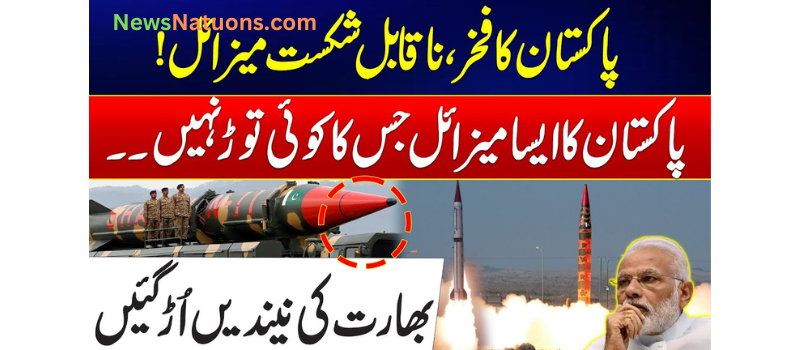The longstanding conflict between Pakistan and India has taken a significant turn in recent months as Pakistan has reportedly developed a new missile system that has no known counter in India’s current defense setup. This development has raised serious concerns in New Delhi, highlighting a growing imbalance in military capabilities between the two neighboring nuclear powers.
Pakistan’s Strategic Missile Breakthrough
According to defense analysts and regional experts, Pakistan has successfully tested a missile with advanced capabilities that India’s existing missile defense systems are unable to intercept. While the exact specifications remain classified, sources suggest this missile could be a hypersonic glide vehicle or a stealth-based delivery system capable of evading radar detection and interception. The missile is said to have high maneuverability, long range, and pinpoint accuracy, making it an effective first-strike or deterrent weapon in a potential conflict.
This breakthrough is seen as a part of Pakistan’s evolving military doctrine, which focuses on deterring Indian aggression and maintaining credible minimum deterrence. Over the past few years, Pakistan has invested heavily in upgrading its missile technology, developing both short-range tactical weapons and long-range strategic systems.
India’s Defensive Dilemma
For India, this new missile poses a major strategic setback. Despite significant investments in defense, including the deployment of the S-400 missile defense system from Russia, Indian forces are reportedly not equipped to handle this new level of threat. The S-400 system, while effective against many aerial threats, may not be fast or accurate enough to track and destroy missiles with hypersonic or stealth technology.
This situation has placed immense pressure on Indian defense planners to reassess their current security framework. Military experts have suggested that India may need to fast-track its own hypersonic programs or seek new technological partnerships to close the gap. The Indian government has not officially confirmed or denied the threat posed by this new Pakistani missile, but internal sources suggest that high-level meetings have taken place to address the issue.
Strategic Implications for the Region
The introduction of a missile with no known counter has altered the strategic equation in South Asia. It not only shifts the balance of power but also increases the risk of miscalculation during periods of high tension. If either side believes it has an overwhelming advantage, the chances of escalation could rise significantly, making any conflict potentially more devastating.
Furthermore, this development comes at a time when relations between the two countries remain strained over Kashmir, cross-border skirmishes, and water disputes. The lack of diplomatic communication and continued hostility only adds to the danger posed by such advanced weapons technology.
Conclusion
Pakistan’s development of a missile system that reportedly has no counter in India represents a major milestone in its defense capabilities and a serious concern for Indian military planners. The situation demands a measured and strategic response to avoid further escalation. Without dialogue and mutual restraint, the arms race between the two nuclear-armed neighbors could threaten regional and global peace.
پاکستان اور بھارت کے درمیان طویل عرصے سے جاری کشیدگی نے ایک نیا رخ اختیار کر لیا ہے، کیونکہ اطلاعات کے مطابق پاکستان نے ایک ایسا نیا میزائل سسٹم تیار کر لیا ہے جس کا بھارت کے پاس فی الحال کوئی مؤثر توڑ موجود نہیں ہے۔ اس پیش رفت نے نئی دہلی میں دفاعی ماہرین اور پالیسی سازوں کو شدید تشویش میں مبتلا کر دیا ہے، اور خطے میں طاقت کا توازن بظاہر پاکستان کے حق میں جھکتا نظر آ رہا ہے۔
پاکستان کی میزائل ٹیکنالوجی میں حیران کن ترقی

ذرائع کے مطابق پاکستان نے حال ہی میں ایک ایسا میزائل کامیابی سے تجربہ کیا ہے جو بھارت کے موجودہ دفاعی نظام سے بچ نکلنے کی صلاحیت رکھتا ہے۔ اگرچہ میزائل کی مکمل تفصیلات خفیہ رکھی گئی ہیں، تاہم دفاعی ماہرین کا کہنا ہے کہ یہ ایک ہائپرسانک گلائیڈ وہیکل یا جدید اسٹیلتھ ٹیکنالوجی پر مبنی میزائل ہو سکتا ہے جو ریڈار سے بچ کر اپنے ہدف کو انتہائی درستگی سے نشانہ بنا سکتا ہے۔ اس کی تیز رفتاری، طویل فاصلے تک مار کرنے کی صلاحیت اور ہوائی دفاع سے بچنے کی خصوصیات اسے پاکستان کی عسکری حکمت عملی میں ایک اہم ہتھیار بناتی ہیں۔
یہ کامیابی پاکستان کی “قابلِ اعتبار کم از کم دفاعی صلاحیت” کی پالیسی کے تحت حاصل کی گئی ہے، جس کا مقصد بھارتی دباؤ کو روکنا اور خطے میں طاقت کا توازن قائم رکھنا ہے۔ پاکستان پچھلے کئی برسوں سے اپنے میزائل پروگرام کو بہتر بنانے کے لیے مسلسل کام کر رہا ہے، جس میں کم فاصلے کے ٹیکٹیکل میزائلز سے لے کر طویل فاصلے تک مار کرنے والے اسٹریٹیجک میزائلز شامل ہیں۔
بھارت کی دفاعی کمزوری
پاکستان کے اس نئے میزائل سسٹم نے بھارت کو دفاعی لحاظ سے ایک مشکل صورت حال سے دوچار کر دیا ہے۔ اگرچہ بھارت نے روس سے جدید S-400 میزائل ڈیفنس سسٹم حاصل کیا ہے، تاہم ماہرین کے مطابق یہ نظام پاکستان کے جدید میزائل کو روکنے میں مؤثر ثابت نہیں ہو سکتا، خاص طور پر اگر میزائل ہائپرسانک ہو یا ریڈار سے بچنے کی صلاحیت رکھتا ہو۔
یہ صورت حال بھارتی دفاعی منصوبہ سازوں کے لیے ایک بڑا چیلنج ہے۔ اب بھارت کو اپنی میزائل دفاعی حکمت عملی پر نظر ثانی کرنی پڑے گی، اور ممکنہ طور پر اپنے ہائپرسانک پروگرامز کو تیز کرنا ہوگا یا دیگر ممالک سے جدید ٹیکنالوجی حاصل کرنے کے لیے شراکت داری کرنی ہوگی۔
خطے میں اسٹریٹیجک اثرات
ایسا میزائل جو موجودہ دفاعی نظام کو چکمہ دے سکے، خطے میں طاقت کے توازن کو تبدیل کر سکتا ہے۔ اس سے دونوں ممالک کے درمیان کشیدگی مزید بڑھ سکتی ہے اور کسی بھی غلط فہمی کی صورت میں تصادم کے خطرات کئی گنا بڑھ جاتے ہیں۔ اس قسم کے جدید ہتھیاروں کی موجودگی خطے کے امن کے لیے خطرناک ثابت ہو سکتی ہے، خاص طور پر جب دونوں ممالک کے تعلقات پہلے ہی کشمیر، پانی کے تنازعات اور سرحدی جھڑپوں کے باعث کشیدہ ہیں۔
نتیجہ
پاکستان کے نئے میزائل سسٹم نے نہ صرف دفاعی میدان میں ایک نمایاں کامیابی حاصل کی ہے بلکہ بھارت کے لیے ایک بڑا چیلنج بھی کھڑا کر دیا ہے۔ اس صورت حال میں دونوں ممالک کے لیے ضروری ہے کہ وہ تحمل اور سمجھ داری کا مظاہرہ کریں اور بات چیت کے ذریعے مسائل کا حل نکالیں۔ بصورت دیگر، اسلحے کی یہ دوڑ نہ صرف جنوبی ایشیا بلکہ پوری دنیا کے لیے ایک سنگین خطرہ بن سکتی ہے۔











